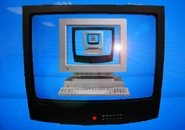Second report in a series on how local stations can use their Web sites to generate new content
by Jeff Gralnick
 Imagine that you’re starting from scratch. You’re going to build an interactive Web site that will help your viewers touch you back, by using all the tools at your disposal. Where can you look for a model?
Imagine that you’re starting from scratch. You’re going to build an interactive Web site that will help your viewers touch you back, by using all the tools at your disposal. Where can you look for a model?
Start by checking the group of sites coordinated by the NBC owned stations. They have come up with a common design that provides instant visual branding. Whether you are in Washington, New York, Miami or Los Angeles, when you visit a site you know you are “home with NBC” by look and feel. What these sites are all doing is making available to their users many higher end interactive tools instead of just one or two and that is something I would suggest as a necessary next step. Employing these tools heightens a sense of community and can only increase your page views.
What the NBC owned station sites offer is a suite of interactive tools which they promote and integrate vigorously in their on air product. In the aggregate they provide a much more complete web experience. Here’s a sample of what you find on these sites all of which is adaptable and adoptable in any market in the country.
User-provided images. At NBC30 in Hartford, CT, there’s a request for “Hot Shots” clearly displayed on the front page and a link to some “pick of the litter” shots one click away on a page that keeps you scrolling. This is handled better at the Miami site, where the “Pic of the Day” is diplayed in a layered archive page that is an invitation to keep on clicking. Each photo is posted with a credit to the viewer/photographer, and there’s an e-mail link to send in your own pictures.
User-provided content. The NBC station sites enlist viewers as reporting eyes and ears, making direct requests for information that can be useful to all viewers and users and also makes for broadcast content. The current branded effort for this station group is Pump Patrol which–you guessed it–focuses on high gasoline prices and asks for viewer alerts to good buys in their viewing areas. What has been created here is a working definition of user-useful and user-friendly content. WTVJ is making a similar effort with Traffic Busters asking users for tips on trouble spots that the station will investigate and then archive on its Web site.
Feedback. NBC 30’s home page also has a direct path to make comments and blow off steam in a branded feature called SoundOff which is pushed both on site and in on air news programming.
Searchable video. All the NBC station sites now offer video on demand and video search using FeedRoom technology, which is also prominently displayed on all the home pages. This is perhaps a step ahead of where many users are now, but it’s there for those who are ready. For those who aren’t, the link is an invitation into the future.
More information. These stations offer an opportunity for TV/Internet convergence with a :CueTV application that automatically takes computer users to “drill-down material” on a story–news, weather, sports or feature–being aired at that moment on one of the station’s news programs. The technology debuted last year on WFAA-TV. While the application’s future is uncertain, providing it gives sites one more opportunity–for the moment, at least–to stretch the possibilities of interaction.
This package of user-involvement and user-assist tools combine to produce an on-site experience better than most I have found. From one station’s standpoint it is also working. Ross Vinocur, NBC30’s interactive manager, says “it is driving traffic and we are seeing positive gains because of it.” Beyond that, Vincocur and his management chose not to comment, which is unfortunate. Their unwillingness to share findings and experiences is a loss.
Other station Web sites have a few additional interactive tools. Several Internet Broadcasting System sites offer a chat forum on local and national issues. KCBS-TV, for example, calls its forum “People’s Poll.” Like many other stations, including the NBC group, KCBS offers free e-mail updates but the range here is impressive, from breaking news every hour (choose them all, or specify the hours) to a surf report, market updates and even a power crisis alert.
If there is a flaw in the NBC sites, and there is, it the mishandling of the simple but critically important function of “Contact Us.” NBC’s Web designers shouldn’t feel too bad, however, because their problem is one that is epidemic on Web sites across the country. Finding and using “Contact Us” is a challenge on almost every site I toured either because of bad design or lack of thought, which closes doors stations need desperately to keep open. If this functionality is hard to use, what kind of message is that sending and what’s a user to think about the rest of the site?
On most of the NBC station front pages, “Contact Us” is buried at the lower left, a lengthy scroll away from the top of the page. On NBC30’s site, it is even worse. To find a way to reach out and touch the station, you’d probably scroll through the home page looking for a “Contact Us” link, but you wouldn’t find one. If you eventually figured out where it’s been hidden, under the NBC30 pulldown menu in an upper navigation bar, you might wonder why you even tried. The contact page offers a phone number and an extremely retro postal mail address, a link to a generic e-mail address, along with a list of people you really would like to ping with e-mail. Under the same pulldown menu, “E-mail Us” gets you a form with just three options: Sound Off, general questions or Webmaster.
What you find on this site is what you find on hundreds of others–either nothing or just an email box into which you can enter a message and send it off in hopes that someone at the station will see it and read it. In 2001, that’s not nearly good enough.
Part one: Enlisting users to supply content
Part three: Making it easy for viewers to make contact
Part four: What’s around the corner for interactive TV news








